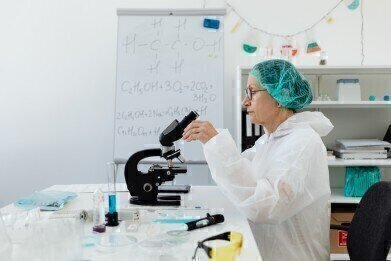News & Views
A Closer Look at 4 Nobel Prize for Chemistry Winners
Oct 29 2014
The Nobel Prize for Chemistry has been won by many well-known recipients including Ernest Rutherford, Marie Curie and Linus Pauling. Nobel’s will states that the prize should go to: “the person who shall have made the most important chemical discovery or improvement…” But what of recent winners — who has won and why?
2014 - Seeing Inside the Cell
The 2014 Nobel Prize in Chemistry went to Eric Betzig, Stefan W. Hell and William E. Moerner for work involving the development of super-resolved fluorescence microscopy. This improvement allows optical microscopes to resolve detail in visible light previously thought impossible. You can read more about this event in, Who Won the 2014 Nobel Prize for Chemistry?
Optical microscopes are now be used to view the inner workings of cells. From their original work, many new techniques have been developed: one is described here in this article: Spinning Disk Super-Resolution Microscopy – Bringing Super-Resolution in Focus for the Cell Biologist.
2013 - Modelling the Reaction
The ability to model chemical reactions in real time, and to map the changes in electron structure, is important to be able to predict the outcome of reactions. Work carried out in the 1970s by Martin Karplus, Michael Levitt and Arieh Warshel allowed chemists to model complex reactions on computers. They managed this by making classical and quantum physics work alongside each other, extending modelling from simple reactions to complex reactions on giant molecules. They were awarded the Nobel Prize in Chemistry in 2013. All three continue to look for ways to model molecules and reactions of interest using a wide variety of techniques.
2012 - Where Are We?
How do your cells know where they are — or what to do next? This remained a mystery until late in the twentieth century. The discovery of how cells know this is important because it allows researchers to understand how medicines and hormones bind to cells and function. The answer was found in G-protein-coupled receptors — a family of receptors located in the cell wall. Around a thousand genes code for these receptors and allow cells to detect light, flavour and odour — and neurotransmitters like dopamine and serotonin. The work on discovering the receptors led to the awarding of the Nobel Prize for Chemistry to Robert Lefkowitz and Brian Kobilka in 2012. They continue to work on receptors — looking for the structure of the receptors and how they work.
2011 - Mathematics and Art
The recipient of the 2011 Nobel Prize, Dan Shechtman, had to fight get his research recognized by the wider chemical community. In solid matter, it was thought that atoms had to be packed inside crystals in ordered arrays — symmetrical patterns that repeated themselves. But in 1982 Shechtman noticed another pattern - the atoms in the crystal under his microscope were packed in a pattern that could not be repeated. Medieval mosaics followed a similar pattern, patterns that are regular but never repeating. Shechtman and his group are still working on quasicrystals — trying to understand more about the structure of these materials. The field has broadened out into a true multidisciplinary field with physicists, crystallographers, mathematicians and others researching the new solids.
Who do you think will win the 2015 Nobel Prize in Chemistry? We want to hear what you think.
Digital Edition
Lab Asia 31.2 April 2024
April 2024
In This Edition Chromatography Articles - Approaches to troubleshooting an SPE method for the analysis of oligonucleotides (pt i) - High-precision liquid flow processes demand full fluidic c...
View all digital editions
Events
Apr 28 2024 Montreal, Quebec, Canada
May 05 2024 Seville, Spain
InformEx Zone at CPhl North America
May 07 2024 Pennsylvania, PA, USA
May 14 2024 Oklahoma City, OK, USA
May 15 2024 Birmingham, UK


















